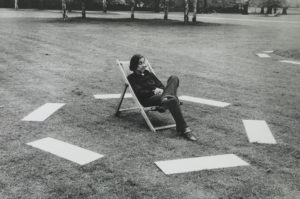Tag: Getty
David Lamelas: A Pioneer in Conceptual Art
New Transcript Release: David Lamelas

In 2017, the Getty Center initiated the exhibit Pacific Standard Time: LA / LA, a multi-gallery art exhibition throughout the Los Angeles area that showcased the interconnections between Latin America and the Los Angeles. In its continuing partnership with the OHC, the Getty Trust sponsored oral histories with a few of the artists featured in the year-long exhibition. David Lamelas was one of the selected artists.
Born in Buenos Aires in 1946, Lamelas would earn international recognition over his career as one of the leading pioneers of conceptual art. He graduated from the Academia Nacional de Bellas Artes in 1963 and soon became a key member of the Instituto Torcuatro di Tella, a group that stood at the center of Argentina’s avant-garde scene. With political turmoil on the rise, he left Argentina in 1968 to study at Saint Martin’s School of Art in London, stopping along the way to represent his home country at the famed Venice Biennial. There his installation, The Office of Information about the Vietnam War at Three Levels, garnered wide praise and attention, introducing Europe to the themes of time, communication, and media that Lamelas would explore in much of his work in the decades to come.
Over the next fifty years, Lamelas continued to push the boundaries of conceptual art. From photography and installations to an impressive array of films, he continually found new ways to explore the topics of media and popular culture, as well as his favorite themes of time and space. He also has continued to be a “citizen of the world,” often splitting his time between Los Angeles, Buenos Aires, and Europe. Indeed, such travel offered ample inspiration for his work. It also made him a fitting choice for the Getty’s Pacific Standard Time: LA / LA exhibition.
For Lamelas’ full oral history transcript, please visit our website.
Lecture: Rembrandt and the Mughals
Rembrandt and the Mughals
Dr. Stephanie Schrader
10 Stephens Hall, UC Berkeley
April 30, 2018, 12:30-2:30
Dr. Stephanie Schrader, Curator, Department of Drawings, J. Paul Getty Museum, Los Angeles will be speaking at UC Berkeley on April 30, from 12:30-2:30 at 10 Stephens Hall. Dr. Stephanie Schrader is the editor of the catalog, and curator of the exhibit, Rembrandt and the Inspiration of India, currently on at the Getty Center through June 24, 2018.
The exhibition catalog can be found in our library: ISBN 9781606065525

Stephanie Schrader will address the 23 drawings Rembrandt made late in his career after Indian paintings that were imported into Amsterdam from Dutch trading post in Surat. Rembrandt’s portraits of Mughal rulers, princes, and courtiers demonstrate how his contact with Indian art inspired him to draw in a different style on Asian paper. Schrader argues that the Mughal compositions Rembrandt copied were not merely foreign curiosities, but carried with them specific associations of empire, trade, luxury, and exceptional artifice.
A reception will follow the talk.
Speaker Bio: Stephanie Schrader is curator at the Department of Drawings at the J. Paul Getty Museum, specialising in 16th to 18th century Dutch and Flemish art. Her interest in cross cultural exchanges include exhibitions, publications, lectures and classes on artists including Jan Gossaert, Maria Sibylla Merian and Peter Paul Rubens.
Sponsors: Department of History of Art Stoddard Lecture Series, Institute for South Asia Studies, Sarah Kailath Chair of India Studies, Department of History of Art.
Ed Ruscha: A New Oral History with the Artist
In partnership with the Getty Trust, we are pleased to release a new oral history with the famed artist Ed Ruscha. Ruscha is an American artist who has specialized in painting, drawing, photography, and books. Born in 1937, Ruscha moved to Los Angeles to attend school at Chouinard Art Institute in 1956. In the early 1960s, he contributed to the birth of “pop art” and his work was featured in the famed 1962 exhibition “New Painting of Common Objects.” In the 1960s, he painted canvases that have since become iconic, including Large Trademark with Eight Spotlights (1961), Standard Station (1963), and Los Angeles County Museum of Art on Fire (1965?68). A signature of his work has been the use of words and phrases, such as in the paintings Optics (1967), Brave Men Run In My Family (1988), and many more. Ruscha also produced an influential series of books based on his photography of the built landscape of Los Angeles, and his continues to document vernacular Los Angeles through photography to this day. He was represented by the Leo Castelli Gallery beginning in the 1970s and then moved to the Gagosian Gallery, which continues to show the artist today. In this interview, Ruscha discusses his art education and influences and his introduction to the burgeoning art world of 1960s Los Angeles. He reflects on the transformation of art after the 1960s with the rise of conceptual and political art and his continuing interest in painting during that era. Finally, Ruscha discusses changes in the art world in the 1980s and 1990s, retrospective exhibitions of his art, the transformation of Los Angeles, and how artists might think about their legacy.